| 流计算风云再起 - PostgreSQL携PipelineDB力挺IoT 原作者:digoal / 德哥 创作时间:2016-12-20 00:13:23+08 |
doudou586 发布于2016-12-22 00:13:23

 评论: 2 评论: 2
 浏览: 24306 浏览: 24306
|
流计算风云再起 - PostgreSQL携PipelineDB力挺IoT
作者: digoal
日期: 2016-12-20
标签: PostgreSQL , pipelinedb , 流计算 , patch , bug , libcheck , zeromq , kafka , kinesis , IoT , 物联网 , 水文监测 , 流量协议分析 , 公安 , 交通 , 物流
背景
pipelinedb是基于PostgreSQL的一个流式计算数据库,纯C代码,效率极高(32c机器,单机日处理流水达到了250.56亿条)。同时它具备了PostgreSQL强大的功能基础,正在掀起一场流计算数据库制霸的腥风血雨。
在物联网(IoT)有非常广泛的应用场景,越来越多的用户开始从其他的流计算平台迁移到pipelineDB。
pipelinedb的用法非常简单,首先定义stream(流),然后基于stream定义对应的transform(事件触发模块),以及Continuous Views(实时统计模块)
数据往流里面插入,transform和Continuous Views就在后面实时的对流里的数据进行处理,对开发人员来说很友好,很高效。
值得庆祝的还有,所有的接口都是SQL操作,非常的方便,大大降低了开发难度。
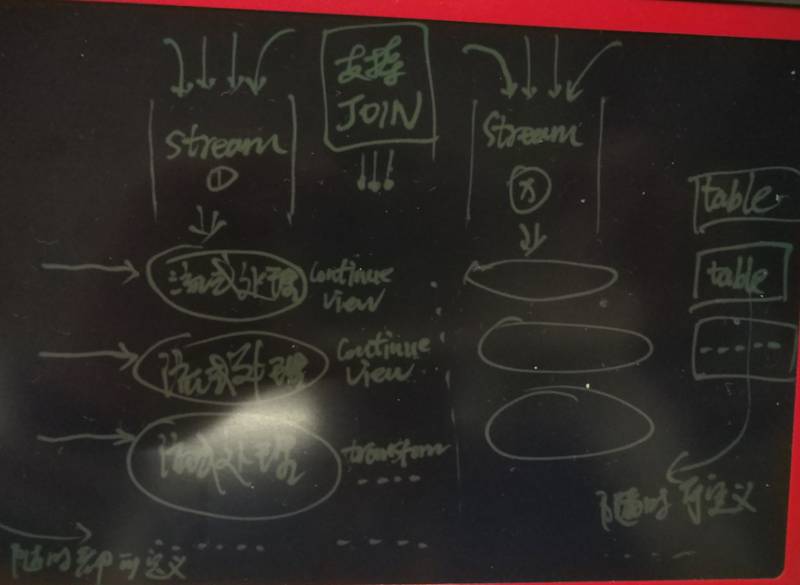
pipelinedb基本概念
1. 什么是流
流是基础,Continuous Views和transform则是基于流中的数据进行处理的手段。
对于同一份数据,只需要定义一个流,写入一份即可。
如果对同一份数据有多个维度的统计,可以写在一条SQL完成的(如同一维度的运算或者可以支持窗口的多维度运算),只需定义一个Continuous Views或transform。如果不能在同一条SQL中完成计算,则定义多个Continuous Views或transform即可。
如果有多份数据来源(例如设计时就已经区分了不同的表)时,定义不同的流即可;
2. 什么是流视图?
流视图,其实就是定义统计分析的QUERY, 例如select id, count(*), avg(x), ... from stream_1 group by ...; 就属于一个流视图。
定义好之后,数据插入流(stream_1),这个流视图就会不断增量的进行统计,你只要查询这个流视图,就可以查看到实时的统计结果。
数据库中存储的是实时统计的结果(实际上是在内存中进行增量合并的,增量的方式持久化)。
3. 什么是Transforms
与流视图不同的是,transform是用来触发事件的,所以它可以不保留数据,但是可以设定条件,当记录满足条件时,就触发事件。
例如监视传感器的值,当值的范围超出时,触发报警(如通过REST接口发给指定的server),或者将报警记录下来(通过触发器函数)。
4. pipelinedb继承了PostgreSQL很好的扩展性,例如支持了概率统计相关的功能,例如HLL等。用起来也非常的爽,例如统计网站的UV,或者红绿灯通过的汽车编号唯一值车流,通过手机信号统计基站辐射方圆多少公里的按时UV等。
Bloom Filter Count-Min Sketch Filtered-Space Saving Top-K HyperLogLog T-Digest
5. Sliding Windows
因为很多场景的数据有时效,或者有时间窗口的概念,所以pipelinedb提供了窗口分片的接口,允许用户对数据的时效进行定义。
例如仅仅统计最近一分钟的时间窗口内的统计数据。
比如热力图,展示最近一分钟的热度,对于旧的数据不关心,就可以适应SW进行定义,从而保留的数据少,对机器的要求低,效率还高。
6. 流视图 支持JOIN,支持JOIN,支持JOIN,重要的事情说三遍。
流 JOIN 流(未来版本支持,目前可以通过transform间接实现)
流 JOIN TABLE(已支持)
欲了解pipelineDB详情请参考: http://docs.pipelinedb.com/
如果你还想了解一下PostgreSQL请参考: 《PostgreSQL 前世今生》
pipelinedb在github上面可以下载。https://github.com/pipelinedb/pipelinedb/releases
pipelinedb适用场景
凡是需要流式处理的场景,pipelinedb都是适用的,例如 :
1. 交通
流式处理交通传感器(如路感、红绿灯)上报的数据,实时的反应交通情况如车流(流视图中完成)。动态的触发事件响应(transform中完成)如交通事故。
2. 水文监测
流式监测传感器的数据,水质的变化,动态的触发事件响应(transform中完成)如水质受到污染。
3. 车联网
结合PostGIS,实现对汽车的位置实时跟踪和轨迹合并,动态的绘制大盘数据(分时,车辆区域分布)。
4. 物流动态
动态的跟踪包裹在每个环节的数据,聚合结果,在查询时不需要再从大量的数据中筛选多条(降低离散扫描)。
5. 金融数据实时处理
例如用户设定了某个股票达到多少时,进行买入或卖出的操作,使用transform的事件处理机制,可以快速的进行买卖。
又比如,实时的对股票的指标数据进行一些数学模型的运算,实时输出运算结果,绘制大盘数据。
6. 公安刑侦
例如在已知可疑车辆的车牌时,在流式处理天眼拍摄并实时上传的车牌信息时,通过transform设置的规则,遇到可疑车牌时,触发事件,快速的知道可疑车辆的实时行踪。
7. app埋点(feed)数据实时分析
很多APP都会设置埋点,方便对用户的行为,或者业务处理逻辑进行跟踪,如果访问量大,数据量可能非常庞大,在没有流式处理前,我们可能需要将数据收集到一个大型的数据仓库,进行离线分析。
但是有些时候,离线分析可能是不够用的,比如要根据用户的实时行为,或者大盘的实时行为,对用户做出一些动态的推荐,或者营销,那么就要用到流式实时处理了。
8. 网络协议层流量分析
比如对办公网络、运营商网关、某些服务端的流量分析。

还有诸多场景等你来发掘。
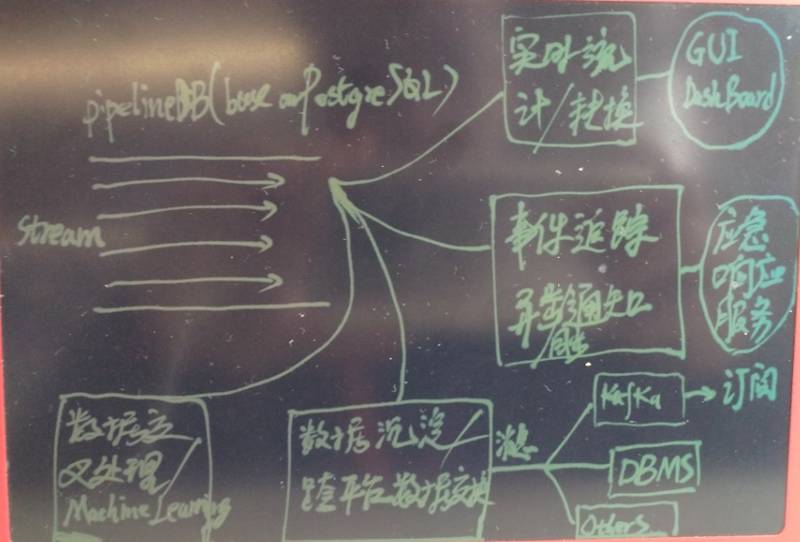
pipelinedb文档中提到的一些例子
--实时监测每个URL的日访问UV
CREATE CONTINUOUS VIEW uniques AS
SELECT date_trunc('day', arrival_timestamp) AS day,
referrer, COUNT(DISTINCT user_id)
FROM users_stream GROUP BY day, referrer;
--实时监测两个列的线性相关性,比如湿度与温度,大盘与贵州茅台,路口A与路口B的车流,某商场的人流量与销售额
CREATE CONTINUOUS VIEW lreg AS
SELECT date_trunc('minute', arrival_timestamp) AS minute,
regr_slope(y, x) AS mx,
regr_intercept(y, x) AS b
FROM datapoints_stream GROUP BY minute;
--最近5分钟的计数
CREATE CONTINUOUS VIEW imps AS
SELECT COUNT(*) FROM imps_stream
WHERE (arrival_timestamp > clock_timestamp() - interval '5 minutes');
--网站的访问品质,99th的用户访问延时, 95th的用户访问延时,.....
CREATE CONTINUOUS VIEW latency AS
SELECT percentile_cont(array[90, 95, 99]) WITHIN GROUP (ORDER BY latency)
FROM latency_stream;
--西斯科方圆1000公里有多少车子
-- PipelineDB ships natively with geospatial support
CREATE CONTINUOUS VIEW sf_proximity_count AS
SELECT COUNT(DISTINCT sensor_id)
FROM geo_stream WHERE ST_DWithin(
-- Approximate SF coordinates
ST_GeographyFromText('SRID=4326;POINT(37 -122)'), sensor_coords, 1000);
pipeline的优势
这是个拼爹的年代,pipelinedb有个很牛逼的爸爸PostgreSQL,出身伯克利大学,有扎实的理论基础,历经了43年的进化,在功能、性能、扩展能力、理论基础等方面无需质疑一直处于领先的位置。
搞流式计算,计算是灵魂,算法和支持的功能排在很重要的位置。
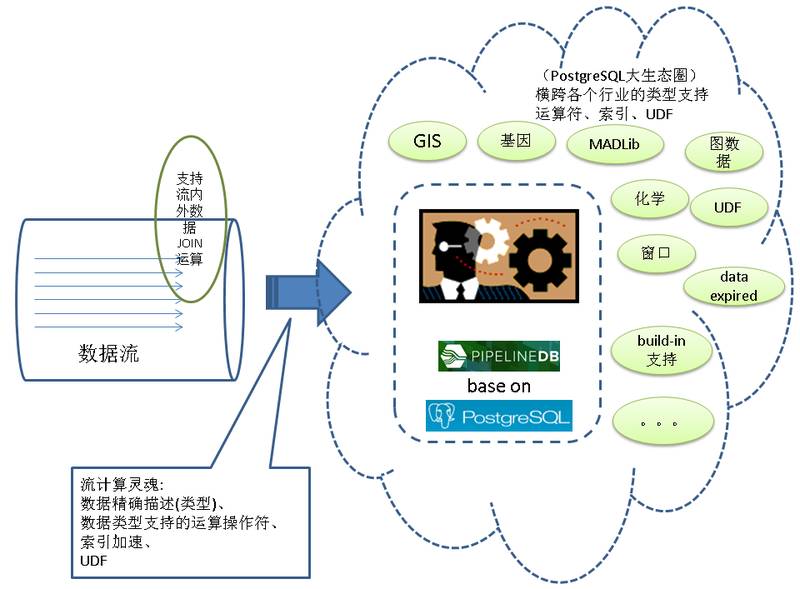
PostgreSQL的强大之处在于统计维度极其丰富,数据类型也极其丰富。
build-in 数据类型参考: https://www.postgresql.org/docs/9.6/static/datatype.html
build-in 聚合,窗口,数学函数请参考: https://www.postgresql.org/docs/9.6/static/functions.html
同时还支持扩展,常见的例如
- MADLib
- PostGIS
- 路径规划
- wavelet
- 基因
- 化学
还有好多好多(为什么这么多?原因是PostgreSQL的BSD-Like许可,致使了PG的生态圈真的很大很大,深入各行各业)。
你能想到的和想不到的几乎都可以在pipelinedb 中进行流式处理,大大提高开发效率。
快速部署pipelinedb
OS最佳部署: 《PostgreSQL on Linux 最佳部署手册》
部署依赖: 安装 zeromq, http://zeromq.org/intro:get-the-software
wget https://github.com/zeromq/libzmq/releases/download/v4.2.0/zeromq-4.2.0.tar.gz tar -zxvf zeromq-4.2.0.tar.gz cd zeromq-4.2.0 ./configure make make install vi /etc/ld.so.conf /usr/local/lib ldconfig
rhel6需要更新libcheck
删除老版本的check
yum remove check
安装 check
http://check.sourceforge.net/
https://libcheck.github.io/check/web/install.html#linuxsource
https://github.com/libcheck/check/releases
wget http://downloads.sourceforge.net/project/check/check/0.10.0/check-0.10.0.tar.gz?r=&ts=1482216800&use_mirror=ncu tar -zxvf check-0.10.0.tar.gz cd check-0.10.0 ./configure make make install
下载pipelinedb
wget https://github.com/pipelinedb/pipelinedb/archive/0.9.6.tar.gz tar -zxvf 0.9.6.tar.gz cd pipelinedb-0.9.6
pipelinedb for rhel 6 or CentOS 6有几个BUG需要修复一下
rhel6需要调整check.h
vi src/test/unit/test_hll.c vi src/test/unit/test_tdigest.c vi src/test/unit/test_bloom.c vi src/test/unit/test_cmsketch.c vi src/test/unit/test_fss.c
添加
#include "check.h"
rhel6需要修复libzmq.a路径错误
libzmq.a的路径修正
vi src/Makefile.global.in LIBS := -lpthread /usr/local/lib/libzmq.a -lstdc++ $(LIBS) 修复test_decoding错误 cd contrib/test_decoding mv specs test cd ../../
编译pipelinedb
export C_INCLUDE_PATH=/usr/local/include:C_INCLUDE_PATH export LIBRARY_PATH=/usr/local/lib:$LIBRARY_PATH export USE_NAMED_POSIX_SEMAPHORES=1 LIBS=-lpthread CC="/home/digoal/gcc6.2.0/bin/gcc" CFLAGS="-O3 -flto" ./configure --prefix=/home/digoal/pgsql_pipe make world -j 32 make install-world
初始化集群
配置环境变量
vi env_pipe.sh
export PS1="$USER@`/bin/hostname -s`-> "
export PGPORT=$1
export PGDATA=/$2/digoal/pg_root$PGPORT
export LANG=en_US.utf8
export PGHOME=/home/digoal/pgsql_pipe
export LD_LIBRARY_PATH=/home/digoal/gcc6.2.0/lib:/home/digoal/gcc6.2.0/lib64:/home/digoal/python2.7.12/lib:
$PGHOME/lib:/lib64:/usr/lib64:/usr/local/lib64:/lib:/usr/lib:/usr/local/lib:$LD_LIBRARY_PATH
export PATH=/home/digoal/cmake3.6.3/bin:/home/digoal/gcc6.2.0/bin:/home/digoal/python2.7.12/bin:
/home/digoal/cmake3.6.3/bin:$PGHOME/bin:$PATH:.
export DATE=`date +"%Y%m%d%H%M"`
export MANPATH=$PGHOME/share/man:$MANPATH
export PGHOST=$PGDATA
export PGUSER=postgres
export PGDATABASE=pipeline
alias rm='rm -i'
alias ll='ls -lh'
unalias vi
假设端口为1922,目录放在/u01中
. ./env_pipe.sh 1922 u01
初始化集群
pipeline-init -D $PGDATA -U postgres -E SQL_ASCII --locale=C
修改配置
cd $PGDATA vi pipelinedb.conf listen_addresses = '0.0.0.0' port = 1922 max_connections = 2000 superuser_reserved_connections = 13 unix_socket_directories = '.' shared_buffers = 64GB maintenance_work_mem = 1GB dynamic_shared_memory_type = posix vacuum_cost_delay = 0 bgwriter_delay = 10ms bgwriter_lru_maxpages = 1000 bgwriter_lru_multiplier = 5.0 synchronous_commit = off full_page_writes = off checkpoint_timeout = 35min checkpoint_completion_target = 0.1 random_page_cost = 1.0 effective_cache_size = 400GB log_destination = 'csvlog' logging_collector = on log_truncate_on_rotation = on log_checkpoints = on log_connections = on log_disconnections = on log_error_verbosity = verbose log_timezone = 'PRC' autovacuum = on log_autovacuum_min_duration = 0 datestyle = 'iso, mdy' timezone = 'PRC' lc_messages = 'C' lc_monetary = 'C' lc_numeric = 'C' lc_time = 'C' default_text_search_config = 'pg_catalog.english' continuous_query_combiner_synchronous_commit = off continuous_query_combiner_work_mem = 2GB continuous_view_fillfactor = 50 continuous_query_max_wait = 10 continuous_query_commit_interval = 500 continuous_query_batch_size = 500000 continuous_query_num_combiners = 12 continuous_query_num_workers = 8
pipelinedb新增的配置
#------------------------------------------------------------------------------ # PIPELINEDB OPTIONS #------------------------------------------------------------------------------ # synchronization level for combiner commits; off, local, remote_write, or on continuous_query_combiner_synchronous_commit = off # maximum amount of memory to use for combiner query executions continuous_query_combiner_work_mem = 512MB # the default fillfactor to use for continuous views continuous_view_fillfactor = 50 # the time in milliseconds a continuous query process will wait for a batch # to accumulate continuous_query_max_wait = 10 # time in milliseconds after which a combiner process will commit state to # disk continuous_query_commit_interval = 50 # the maximum number of events to accumulate before executing a continuous query # plan on them continuous_query_batch_size = 50000 # the number of parallel continuous query combiner processes to use for # each database continuous_query_num_combiners = 2 # the number of parallel continuous query worker processes to use for # each database continuous_query_num_workers = 2 # allow direct changes to be made to materialization tables? #continuous_query_materialization_table_updatable = off # synchronization level for stream inserts #stream_insert_level = sync_read # continuous views that should be affected when writing to streams. # it is string with comma separated values for continuous view names. #stream_targets = '' # the default step factor for sliding window continuous queries (as a percentage # of the total window size) #sliding_window_step_factor = 5 # allow continuous queries? #continuous_queries_enabled = on # allow anonymous statistics collection and version checks? #anonymous_update_checks = on
启动pipelinedb
pipeline-ctl start
连接方法
如何连接PostgreSQL,就如何连接pipelinedb,它们是全兼容的。
psql
psql (9.5.3)
Type "help" for help.
pipeline=# \dt
No relations found.
pipeline=# \l
List of databases
Name | Owner | Encoding | Collate | Ctype | Access privileges
-----------+----------+-----------+---------+-------+-----------------------
pipeline | postgres | SQL_ASCII | C | C |
template0 | postgres | SQL_ASCII | C | C | =c/postgres +
| | | | | postgres=CTc/postgres
template1 | postgres | SQL_ASCII | C | C | =c/postgres +
| | | | | postgres=CTc/postgres
(3 rows)
pipeline=#
测试
创建流结构
id为KEY, val存储值,统计时按ID聚合
CREATE STREAM s1 (id int, val int);
创建流式视图
流视图统计count, avg, min, max, sum几个常见维度
CREATE CONTINUOUS VIEW cv1 AS SELECT id,count(*),avg(val),min(val),max(val),sum(val) FROM s1 GROUP BY id;
PostgreSQL的强大之处在于统计维度极其丰富,数据类型也极其丰富。
build-in 数据类型参考: https://www.postgresql.org/docs/9.6/static/datatype.html
build-in 聚合,窗口,数学函数请参考: https://www.postgresql.org/docs/9.6/static/functions.html
同时还支持扩展,常见的例如 PostGIS, wavelet, 基因,化学,图类型,等等。
你能想到的和想不到的都可以在pipelinedb 中进行流式处理,大大提高开发效率。
激活流计算
activate ;
插入压测
100万个随机group,插入的值为500万内的随机值
vi test.sql \setrandom id 1 1000000 \setrandom val 1 5000000 insert into s1(id,val) values (:id, :val);
使用1000个连接,开始压测,每秒约处理24万流水
pgbench -M prepared -n -r -P 1 -f ./test.sql -c 1000 -j 1000 -T 100 ... progress: 2.0 s, 243282.2 tps, lat 4.116 ms stddev 5.182 progress: 3.0 s, 237077.6 tps, lat 4.211 ms stddev 5.794 progress: 4.0 s, 252376.8 tps, lat 3.967 ms stddev 4.998 ...
如果主机有很多块硬盘,并且CPU很强时,可以在一台主机中部署2个或多个pipelinedb实例,进行分流。
比如我在32Core的机器上,部署2个pipelinedb实例,可以达到29万/s的流处理能力,一天能处理 250.56亿 流水。
小伙伴们都惊呆了。
250.56亿,使用jstrom框架的话,估计要几十倍甚至上百倍于pipelinedb的硬件投入才能达到同样效果。
pipelinedb集群化部署
虽然pipelinedb的性能很强(前面测的32C机器约250.56亿/天的流水处理能力),但是单机总会有瓶颈,所以我们还是需要考虑集群化的部署。
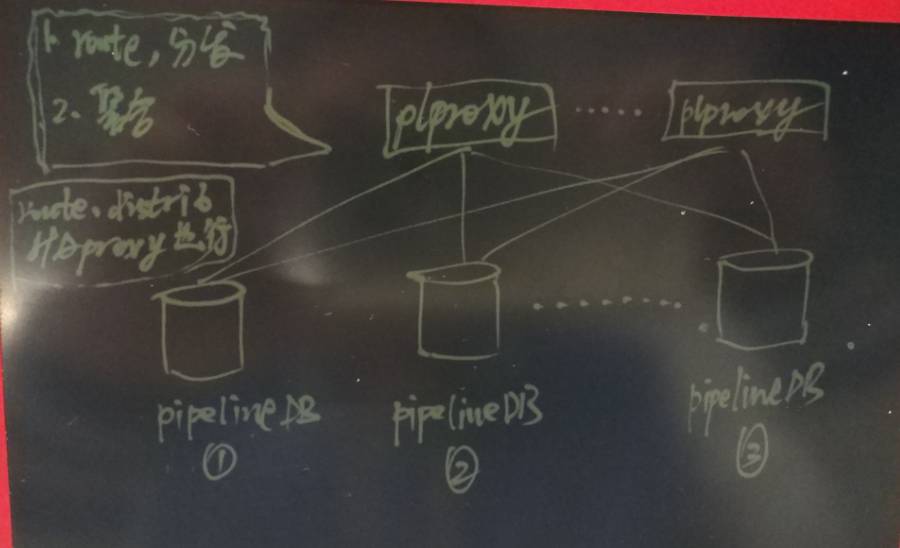
写入操作,如果不需要特定的分片规则,使用haproxy分发就可以了。如果需要加入分片规则,可以使用plproxy。
查询聚合,需要使用plproxy,非常简单,写个动态函数即可。
plproxy 相关文档介绍
《A Smart PostgreSQL extension plproxy 2.2 practices》
《PostgreSQL 最佳实践 - 水平分库(基于plproxy)》
pipelinedb 文档结构: http://docs.pipelinedb.com/
从文档目录,可以快速了解pipelinedb可以干什么,可以和什么结合,处理那些场景的问题?
1. 介绍
What PipelineDB is What PipelineDB is not
2. Continuous Views
定义流视图,其实就是定义 统计分析的QUERY, 例如select id, count(*), avg(x), ... from table group by ...;
定义好之后,数据插入table,这个流视图就会不断增量的进行统计,你只要查询这个流视图,就可以查看到实时的统计结果。
数据库中存储的是实时统计的结果(实际上是在内存中进行增量合并的,增量的方式持久化)。
CREATE CONTINUOUS VIEW DROP CONTINUOUS VIEW TRUNCATE CONTINUOUS VIEW Viewing Continuous Views Data Retrieval Time-to-Live (TTL) Expiration Activation and Deactivation Examples
3. Continuous Transforms
与流视图不同的是,transform是用来触发事件的,所以它可以不保留数据,但是可以设定条件,当记录满足条件时,就触发事件。
例如监视传感器的值,当值的范围超出时,触发报警(如通过REST接口发给指定的server),或者将报警记录下来(通过触发器函数)。
CREATE CONTINUOUS TRANSFORM DROP CONTINUOUS TRANSFORM Viewing Continuous Transforms Built-in Transform Triggers Creating Your Own Trigger
4. Streams 流视图和transform都是基于流的,所以流是基础。
我们首先需要定义流,往流里面写数据,然后在流动的数据中使用流视图或者transform对数据进行实时处理。
Writing To Streams Output Streams stream_targets Arrival Ordering Event Expiration
5. Built-in Functionality 内置的函数
General Aggregates PipelineDB-specific Types PipelineDB-specific Functions Miscellaneous Functions
6. Continuous Aggregates
聚合的介绍,通常流处理分两类,即前面讲的
流视图(通常是实时聚合的结果),比如按分钟实时的对红绿灯的车流统计数据绘图,或者按分钟对股票的实时数据进行绘图。
transform(事件处理机制),比如监控水质,传感器的值超出某个范围时,记录日志,并同时触发告警(发送给server)。
PipelineDB-specific Aggregates Combine CREATE AGGREGATE General Aggregates Statistical Aggregates Ordered-set Aggregates Hypothetical-set Aggregates Unsupported Aggregates
7. Clients
几种常见的客户端用法,实际上支持PostgreSQL的都支持pipelinedb,他们的连接协议是一致的。
Python Ruby Java
8. Probabilistic Data Structures & Algorithms
概率统计相关的功能,例如HLL等。用起来也非常的爽,例如统计网站的UV,或者红绿灯通过的汽车编号唯一值车流,通过手机信号统计基站辐射方圆多少公里的按时UV等。
Bloom Filter Count-Min Sketch Filtered-Space Saving Top-K HyperLogLog T-Digest
9. Sliding Windows
因为很多场景的数据有时效,或者有时间窗口的概念,所以pipelinedb提供了窗口分片的接口,允许用户对数据的时效进行定义。
例如仅仅统计最近一分钟的时间窗口内的统计数据。
比如热力图,展示最近一分钟的热度,对于旧的数据不关心,就可以适应SW进行定义,从而保留的数据少,对机器的要求低,效率还高。
Examples Sliding Aggregates Temporal Invalidation Multiple Windows step_factor
10. Continuous JOINs
流视图 支持JOIN,支持JOIN,支持JOIN,重要的事情说三遍。
流 JOIN 流(未来版本支持,目前可以通过transform间接实现)
流 JOIN TABLE(已支持)
Stream-table JOINs Supported Join Types Examples Stream-stream JOINs
11. Integrations
pipelinedb继承了PostgreSQL的高扩展性,所以支持kafka, aws kinesis也是易如反掌的,可以适应更多的场景。
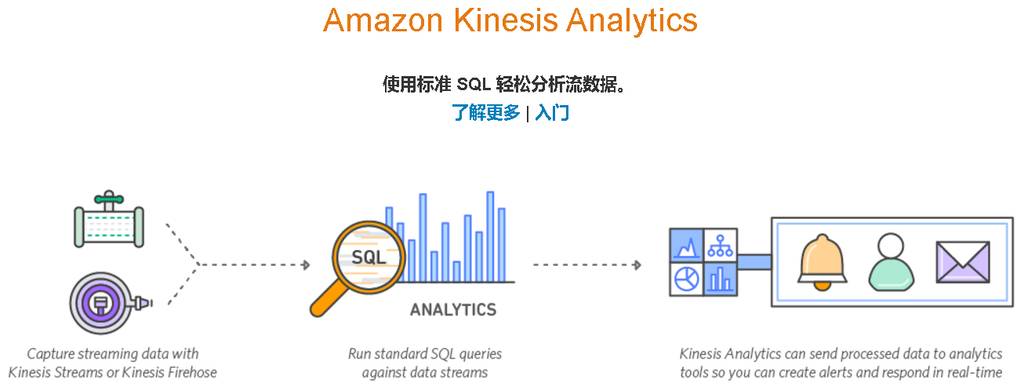
https://aws.amazon.com/cn/kinesis/streams/
Apache Kafka Amazon Kinesis
12. Statistics, 统计信息,对于DBA有很大的帮助
pipeline_proc_stats pipeline_query_stats pipeline_stream_stats pipeline_stats
13. Configuration
参考
https://yq.aliyun.com/articles/166

请在登录后发表评论,否则无法保存。
